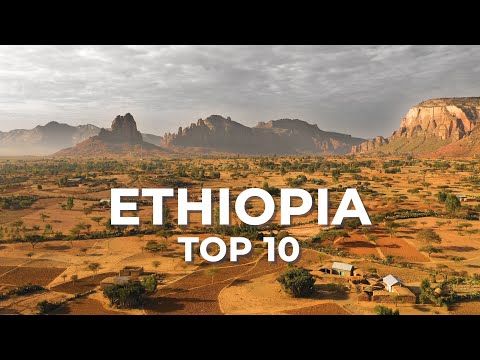Journey Through Ethiopia - Africa Travel Documentary

Ethiopia is one of Africa's most beautiful and fascinating countries and a surprising travel destination. From spectacular mountain landscapes to vast lakes and mysterious deserts. From incredible historic landmarks to vibrant modernizing cities. It is the only country in Africa that was never colonized by Western powers, and has a rich cultural heritage, which evolved during times of kingdoms and empires. While Christianity and Islam are the main religions, Ethiopia is also a patchwork of many different ethnicities, customs, and traditions, including tribes that have retained some of their lifestyle.
In this video, I will show you 10 beautiful places I visited, on a journey through Ethiopia in 2019. At the time of editing this video, Ethiopia is in political and military conflict with the Northern Tigray region, which is causing great suffering to ordinary civilians. Like most people, I hope all parties involved can come to an agreement, and start rebuilding this incredible land. As a result of the conflict, some of the places in this video are currently inaccessible due to high security concerns.
Always follow travel advice, and consult local guides, to avoid putting yourself and others at risk. We begin this journey in the North of Ethiopia, to visit the incredible monolithic churches of Lalibela. Little can prepare you for the sight of these structures, that are carved entirely out of rock. Construction began some 800 years ago, during the reign of a king named Lalibela, who, according to legend, wanted to build a new Jerusalem, and center for Christianity. Today, Lalibela remains an important place of worship for the Ethiopian Orthodox community. And you can see pilgrims praying and chanting in all corners of town, especially during Sunday mass.
Traveling to the Danakil Depression is like stepping into a different world. This is one of the hottest and most inhospitable places on Earth. And can only be reached with experienced tour companies, on an overnight expedition. But for those who make it here, a surreal landscape awaits, with sulfur springs, bubbling volcanoes, acidic pools, and salt lakes.
While traversing the vast desert, you may come across groups of nomadic Afar people, busy cutting chunks of salt out of the plains. They spend weeks following an ancient salt route, eventually selling or exchanging their salt on local markets. Set in a landscape of sandy desert and sharp peaks, is the incredible Abuna Yemata Guh rock-hewn church.
Located in the troubled, yet beautiful Tigray region, this church is one of the most unique places of worship in Ethiopia, if not in the world. Built halfway up a sheer rock pinnacle, Abuna Yemata Guh can only be reached via a steep, and sometimes terrifying, 2 hour climb. The site is managed by 20 or so clergymen, and some of the priests make the journey up here every day.
There are over 100 other rock-hewn churches in this region, and each have their own distinct character and style. The striking Simien Mountains National Park is one of Africa's most beautiful ranges. It was formed more than 40 million years ago, as a result of countless volcanic eruptions, that created a plateau with jagged peaks and pinnacles. Today, it offers travelers plenty of opportunity for short hikes and longer treks, on which you are likely to meet gelada baboons, nicknamed as 'bleeding heart monkeys'. These sociable monkeys are unique to this area, and can live up to 4,500 meters, making them the highest dwelling primates on our planet. Gondar is home to some of Ethiopia's most visually striking monuments, with royal palaces, churches, and castles.
The city flourished for over a century after Emperor Fasilidas made it his capital almost 400 years ago, due to its strategic location. Many of the original buildings remain intact, or have been renovated, including the beautiful Fasil Ghebbi fortress, and the unusual Fasilidas' Bath. In the far North of Ethiopia lies Aksum, a small city with great historic significance. This was the center of one of humanity's great forgotten civilizations, the Aksumite Empire, which dominated trade in this region for many centuries.
Aksum is filled with ancient sites, including the eye-catching stelea, or obelisks, that served as tombstones and memorials. And the remains of the Dungur, popularly known as Queen Sheba's Palace. Yet the grounds of the Church of Saint Mary of Zion may be the most compelling reason for people to visit Aksum. According to Ethiopian legend, this is where the famous Ark of the Covenant is hidden, in a small but strictly guarded chapel.
After traversing the North, we arrive in the center of Ethiopia, to visit the bustling capital city, Addis Ababa. Home to more than 5 million Ethiopians, Addis attracts people from all over the country to work, study, and live. It's a vibrant metropolis and serves as a great introduction to Ethiopian culture and food.
Addis is a sprawling city, and navigating the busy streets can sometimes feel challenging. However, there are plenty of areas to visit, including downtown Meskel Square, the city's old town, some great museums, and my personal favorite the crowded Mercato, said to be the largest market in Africa. South Ethiopia is a distinctly different land from the North, with Arba Minch as one of the main cities. But it's not the urban life that attracts visitors to Arba Minch. Rather, the spectacular Nechisar national park.
Located in the Great Rift Valley, Nechisar boasts two of Ethiopia's largest lakes. One of them, Chamo, is especially popular for its large populations of crocodiles. You can also spot other wildlife here, such as pelicans, hippos, and the charming olive baboons, who may casually wander around the garden of your hotel.
Set in the cool mountains near Arba Minch, live the friendly Dorze people, known for their towering homes, made from bamboo and 'ensete' leaves. These leaves are also the main ingredient for 'kocho', a bread like fermented food that is sometimes used instead of the famous injera. Cotton weaving and pottery are important sources of livelihood here, as is agriculture. The Dorze grow their own coffee beans, and visitors are often treated to an Ethiopian coffee ceremony, with freshly roasted beans, grounded on the spot. We finish this journey through Ethiopia in the Omo Valley, which is truly a destination in itself. The area of Konso is regarded as the jumping off point for the valley, with incredible villages built on terraced hillsides, among sometimes surreal eroded landscapes.
The terrain slowly changes as you enter the Lower Omo Valley, a region that is home to a wide variety of ethnic groups, who all have their own characteristics and traditions. It's a fascinating area that gives travelers a chance to get up close with some of Africa's most unique tribes. Traveling here comes with great responsibility, as these destinations often run the risk of turning into so called 'human safaris'.
Make sure to interact with people, and get to understand them, before considering to take any photos. Tourism can have a positive effect, and for some of the villages it's an important, or even crucial, source of income. But it's important that it happens in a respectful and meaningful way. If anywhere I would recommend hiring local guides, it is here.
And that concludes my journey through Ethiopia, a country filled with amazing people, spectacular landscapes, incredible wildlife, and unique cultures and traditions. I hope this video gave you some new insights, but above all I wish the people of Ethiopia a safe and promising future. Take care, everyone.
2021-10-09 17:37


